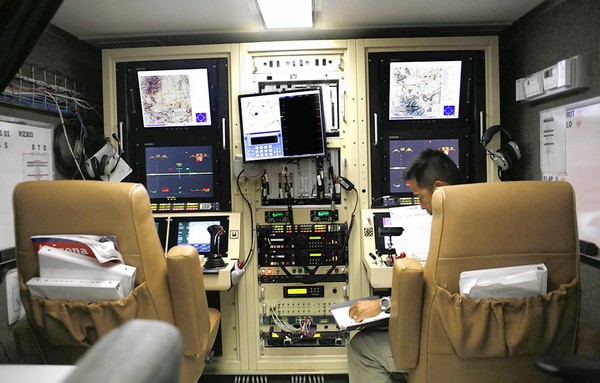
Customs & Border Protection Predator B Ground Control Station - Photo: Brian Bennett/Los Angeles Times/MCT
In mid-June, as the largest wildfire in Arizona history raged, US Customs and Border Protection Officer David Gasho sent one of the Predator Bs over residential neighbourhoods in search of rogue brush fires. Working from an air-conditioned trailer, his crew aimed an airborne infrared camera through thick smoke and spotted a smoldering blaze. Using coordinates fed from the UAS, airborne firefighters then doused the hot spot from helicopters and watched over a secure Internet feed as the heat signature of the flames cooled.
It was the latest example of once-secret military hardware finding routine civilian uses. Seven surveillance UAS are chiefly used to help patrol America’s northern and southern borders. But in recent months, they also have helped state and local authorities fight deadly fires, survey damage from floods and tornadoes, and inspect dams and levees.
“People are constantly coming up and wanting a piece of that Predator pie,” said Gasho, a former commercial pilot who heads the Customs and Border Protection air operations in Sierra Vista, Ariz., standing beside one of the drones at Libby Army Airfield.
Between March and July, for example, dozens of UAS missions were flown between Grand Forks, N.D., and Columbia, Mo. The Predators provided first responders and engineers with live video and radar images of widespread flooding along the Soris, Red and Missouri rivers.
During the summer, drones flew along the Louisiana Gulf Coast and up the Mississippi River to inspect flood damage and the integrity of levees.
Operators studying the feeds look for signs that a levee is bulging from pressure of floodwaters, and advise where a swollen river may first overflow its banks. Local officials can then order evacuations and direct help to vulnerable neighborhoods.
In addition to three Predators in Arizona, Customs and Border Protection crews operate two drone aircraft out of Grand Forks, N.D., one from Corpus Christi, Texas, and another in Cocoa Beach, Fla. Plans call for adding three more aircraft later this year.
In April, when ice piled up under bridges and caused the Red River to overflow its banks, a Customs and Border Protection drone flew out of Grand Forks to survey the river around Oslo, Minn. Watching the live footage from the unmanned plane, officials were able to spot a clay levee that appeared about to break and quickly shored it up.
Without the live footage, engineers and rescue teams might not have reached the right place in time, officials said.
“We would have lost a small town of 50 to 80 homes,” said Kim Ketterhagen, the mutual aid coordinator for Minnesota’s homeland security and emergency management department.
Source: LA Times
